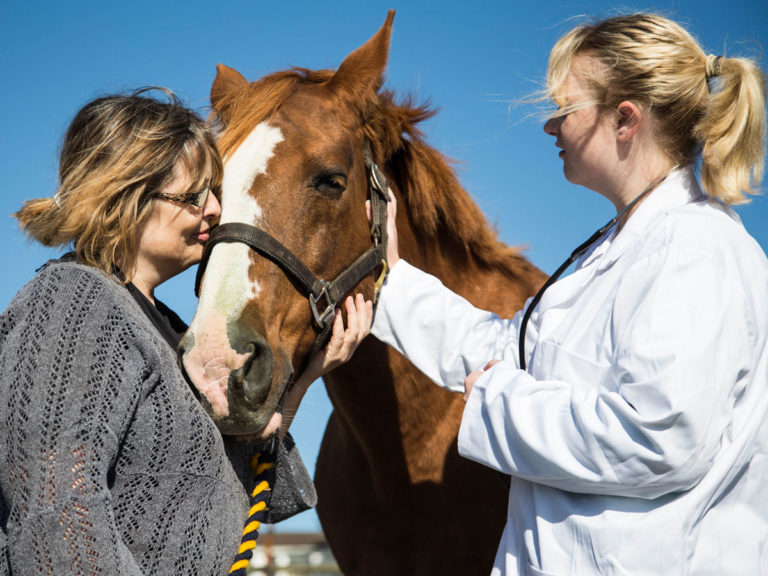
Every veterinarian faces hoof cracks in horses during practice. The most common are quarter cracks and toe cracks.
“A quarter crack is a defect that originates in the coronary band and migrates toward the ground,” said Steve O’Grady, DVM, MRCVS, and a farrier with 40 years of experience, who owns Virginia Therapeutic Farriery. “But you can have ground surface cracks that migrate to the coronary band.”
O’Grady said toe cracks are not as common. They generally occur in the center of the toe. “These also originate at the coronary band and migrate down,” said O’Grady. “It stops usually near the ground surface.”
O’Grady said in these types of hoof cracks in horses, he usually sees a dish or concavity where the crack occurs. “A toe crack is movable and causes pain,” he advised. “When they put weight on the crack it closes, and when the foot is off the ground the crack opens.”
Hoof Cracks in Horses and Working Equids
O’Grady said working in third-world countries with working equids you rarely see hoof cracks in horses.
“Those horses and mules rarely wear shoes,” he noted. “And you rarely see [hoof cracks in horses] that are barefoot. It’s a consequence of putting shoes on and the trim.”
Hoof Cracks in Competition Horses
O’Grady said he sees a lot of hoof cracks in competition horses due to the stress on the hoof. “It can be career-interrupting,” he said. “Sometimes they are full thickness to the dermis, and you have bleeding. “
He noted that in 50 years of working on horses, he rarely sees quarter cracks unless the horse has a sheered heel. “One heel bulb is displaced higher than the other,” O’Grady said. “The one that is displaced it up, increasing the load. That causes asymmetrical loading.”
Hoof Cracks in General Horse Populations
O’Grady said veterinarians need to be aware of the differences in foot conformation and the causes of cracks. For instance, a horse with a narrow chest and a rotational deformity of the forelimbs contacts the ground with uneven loading.
“Repetitive overloading leads to a fracture or crack,” said O’Grady.
O’Grady said the owner or trainer might want the veterinarian and farrier to repair the crack and let the horse go back into training. However, his thought is that the veterinarian needs to figure out what is causing the crack and change the farriery and conformation of the hoof capsule. Then the crack will start to heal.
About Dr. Steve O’Grady
Steve O’Grady, DVM, MRCVS, was a professional farrier for 10 years prior to obtaining his degree in veterinary medicine. He learned the farrier trade through a formal three-year apprenticeship under “Hall of Fame” farrier, Joseph M. Pierce, of West Chester, Pennsylvania. He then returned to school, attended Haverford College and went on to graduate from the University of Pretoria, Faculty of Veterinary Science in South Africa with a DVM Degree in 1981.
After graduating from veterinary school, Dr. O’Grady did an equine internship in Cape Town, South Africa. From here he went on to join Dr. Dan Flynn at the prestigious Georgetown Equine Hospital in Charlottesville, Virginia where he stayed for 10 years before opening his own practice in Keswick, VA devoted to treating competition horses and farriery.
In 2003, he opened Northern Virginia Equine in Marshall, Virginia. O’Grady moved back to Keswick, Virginia, in 2014 and opened Virginia Therapeutic Farriery. Both are referral practices devoted to foot disease and equine therapeutic farriery.
Dr. O’Grady combines his skills as a veterinarian and a farrier to better understand and treat problems of the foot. He has published 33 peer-reviewed papers in the veterinary literature, numerous papers in the farrier literature, written 18 book chapters and edited two editions of Veterinary Clinics of North America on equine podiatry and therapeutic farriery – all resulting from his extensive work in equine podiatry.
In 2003, he was inducted into the International Equine Veterinarians Hall of Fame and in 2009, he received the AAEP President’s Award for his work in farrier education. In 2019, he was awarded the coveted gold medal from the South African Veterinary Association. O’Grady was acknowledged for his commitment to the education of equine practitioners around the world and received AAEP’s 2020 Distinguished Educator Award.
Further Reading on Hoof Cracks in Horses
“Sheared heels and the correlation to spontaneous quarter cracks” authored by S.E. O’Grady and H. H. Castelijns
“Quarter crack repair: an overview” authored by S.E. O’Grady








